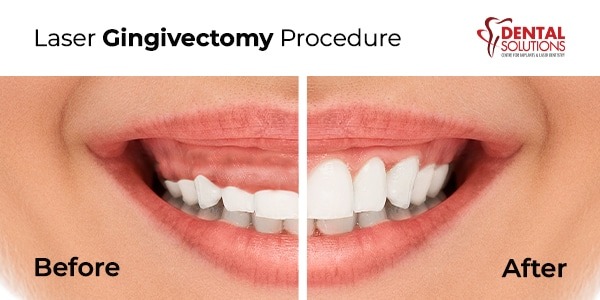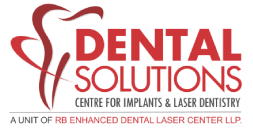laser Gingivectomy procedure

Laser Gingivectomy Procedure and Treatment
Laser Gingivectomy is the surgical removal of the gingiva (gum tissue) using advanced Lasers – a minimally invasive to moderate oral surgery. The technique controls tissue overgrowth and improves the appearance of teeth by removing the gingiva.
Gingivectomy is a procedure that can be done to treat gingivitis. It's also used to remove excess gum tissue for aesthetic purposes, such as to change the appearance of a smile.
Gingivectomy may be recommended by a dentist if you have gum recession as a result of:
Gum illnesses such as gingivitis, periodontitis and bacterial infections, or gum damage, which is common among the elderly. Gingivectomy for cosmetic reasons is completely up to the patient, however, it is best to take your oral surgeon's advice before going ahead with this procedure.
Is Gingivectomy the best option?
When it comes to cosmetic reasons, gingivectomy costs are fairly decent compared to advanced smile makeover treatment. But what's more interesting is that this treatment is minimally invasive and usually quick, depending on the case. Most dental clinics, including ours, now conduct a gingivectomy procedure using a soft tissue laser.
In other cases, a gingivectomy serves a health purpose rather than improving the aesthetics of your smile. If you have had gum disease in the past but still have deep pockets surrounding your teeth, you won't be able to clean them on your own. By removing some of the detached gingiva surrounding your tooth, pocket reduction surgery, also known as periodontal gingivectomies or crown lengthening, can minimize the depth of your gum pocket. Pockets that are shorter are easier to maintain clean and healthy.
Laser gingivectomy – The What & How?
In the past, gingivectomy was seen as a more invasive dental procedure that concerned many individuals. This is because it was formerly done using a scalpel, which gave a rather unpleasant experience for the patient. The healing process took a few weeks too.
Today, lasers are used as the primary tool in a number of dental treatments. Clinicians can choose from a variety of technologies depending on the application, as different treatments require different laser wavelengths owing to the way tissue reacts. Dental lasers include those that are used on soft tissue (such as Nd:YAG, diode, and 10.6.m CO2 units), hard-tissue lasers (such as Er:YAG and Er,Cr:YSGG), and technologies that are selectively suited for either hard or soft tissue procedures (such as Er:YAG and 9.3-m CO2 units).

The most common procedure performed using dental lasers is laser gingivectomy. For restorative, aesthetic, and periodontal purposes, all laser wavelengths can be utilized to accurately incise gingiva.
As we know, Gingivectomy is a surgical treatment that involves removing unsupported gingival tissue. This removal must be to a point where the gingiva is connected and forming a new gingival edge that is apical to the previous one. The biological width, which is roughly 2.14mm(0.97mm of epithelial attachment and 1.07 mm of the connective tissue attachment), should not be exceeded when conducting a gingivectomy. Maintaining this width is necessary for maintaining gingival health, as encroaching on it might result in gingival recession or gingival rebound.
The diode laser is most commonly used in Gingivectomy. It is highly absorbable by haemoglobin and melanin, allowing for easier soft-tissue manipulation during gingival recontouring, as well as better epithelization and healing. Heat is created during laser usage, resulting in coagulation, drying, and vaporization at the energy absorption site, which prevents bleeding by closing blood vessels and suppressing pain receptors at the incision site. The diode laser's incision depth ranges from 9 2 to 6mm.
Laser gingivectomy has more advantages over traditional scalpel treatment in terms of
- Faster healing – Cutting into the sensitive tissues of the gums with a scalpel during a typical gingivectomy can be difficult to gauge correctly. Sutures are used to seal the wound after surgery, causing additional puncture wounds in the mouth. Laser gingivectomy, on the other hand, cauterises the wound, sealing it against bacteria and germs. As a result, healing times are significantly reduced. In addition, laser gingivectomy generates less tissue damage, which reduces recovery time.
- Less Painful – Ideally, neither procedure should cause pain to the patient. Both utilize local anaesthetic to numb the region to be worked on, so the only sensation you'll have is pressure throughout the treatment. The only variation appears to be the quantity of anaesthetic required. Patients who choose laser gingivectomy may require less than those who choose surgical gingivectomy. This might be because the laser can be more exact, therefore anaesthesia isn't required as widely as is in traditional methods. Also, post-treatment pain is lesser in laser treatment compared to traditional scalpel treatment
What to expect during the laser gingivectomy procedure?
- To numb the region, local anesthesia will be injected.
- Using the laser, the dentist will remove the required sections of gum tissue. Soft tissue incision is the term for this procedure.
- During the process, your dentist will most likely use a suction instrument to remove extra saliva from your mouth.
- Next, a laser instrument to vaporize leftover tissue will be used. After the tissue has been taken away, the dentist will sculpt the gum line.
- To protect your gums while they recover, your dentist will apply a soft putty-like material to the area.
Recovery From A Laser Gingivectomy
You will not need much recovery time after a dental laser gingivectomy. There will be some amount of discomfort once the numbing drug wears off, but that's all. Remember, laser reduces swelling and inflammation, which are two of the most common causes of pain. Patients who have had a laser gingivectomy can normally resume normal activities within a day or two.
Healing might take longer if you have undergone a traditional surgical gingivectomy with a scalpel. Lasers are known to pre-heal the surgical site in a way that a scalpel can't. In the traditional method, your dentist will apply a medicinal dressing to your newly constructed gumline to minimize bleeding, relieve discomfort, and reduce irritation and damage to the area. This dressing will be taken off in 5-7 days.
Whichever method is used, it is important to continue taking care of your mouth. To relieve any discomfort or irritation, try to apply a cool compress to your cheeks. Keep the area free of germs or other irritating things, by using a warm saltwater rinse or saline solution, but avoid mouthwash or other antiseptic solutions. Follow the medication as prescribed by your dentist, antibiotics may also be required to prevent gum infections.
For any more queries, feel free to reach out to us – We are proud to be among the most trusted dental clinics in Bangalore, having the most professional dentist and using the latest dental technologies – including laser dental treatments in Bangalore.
